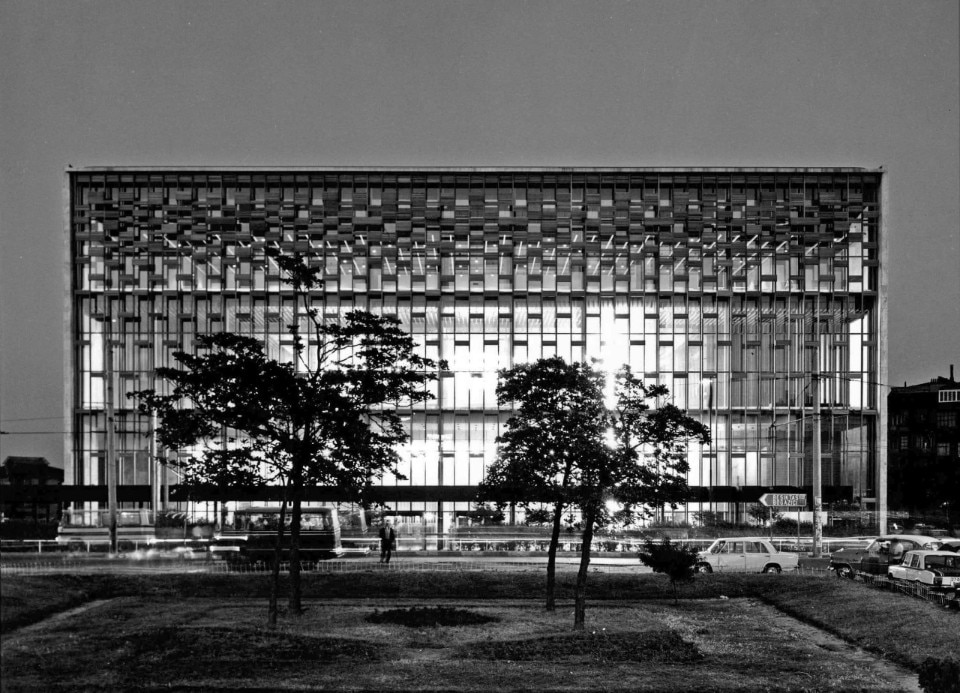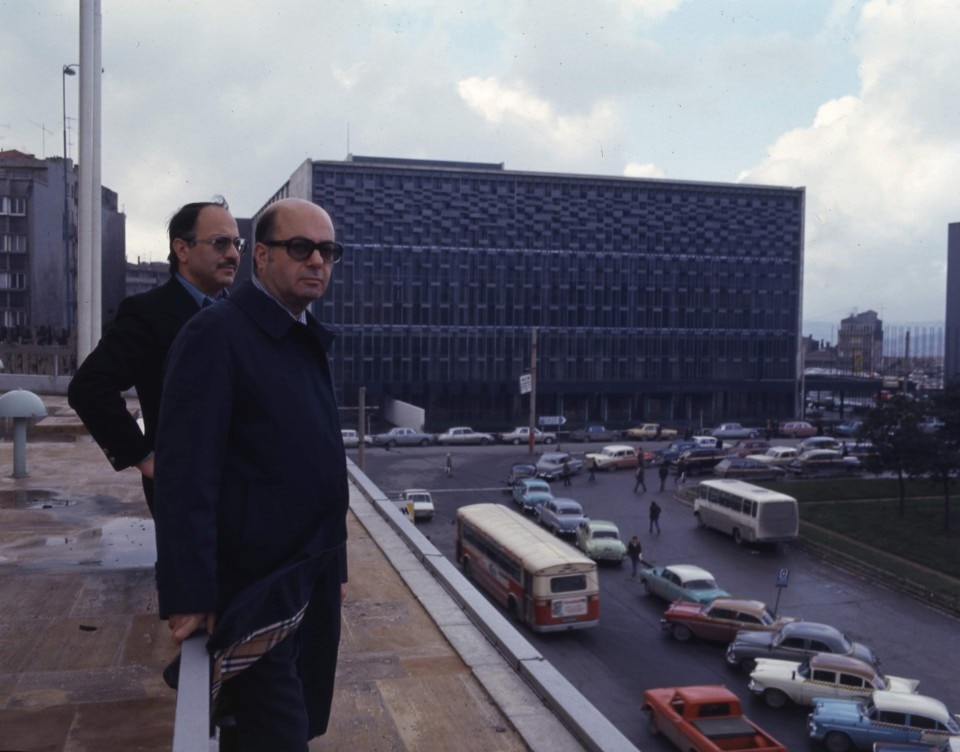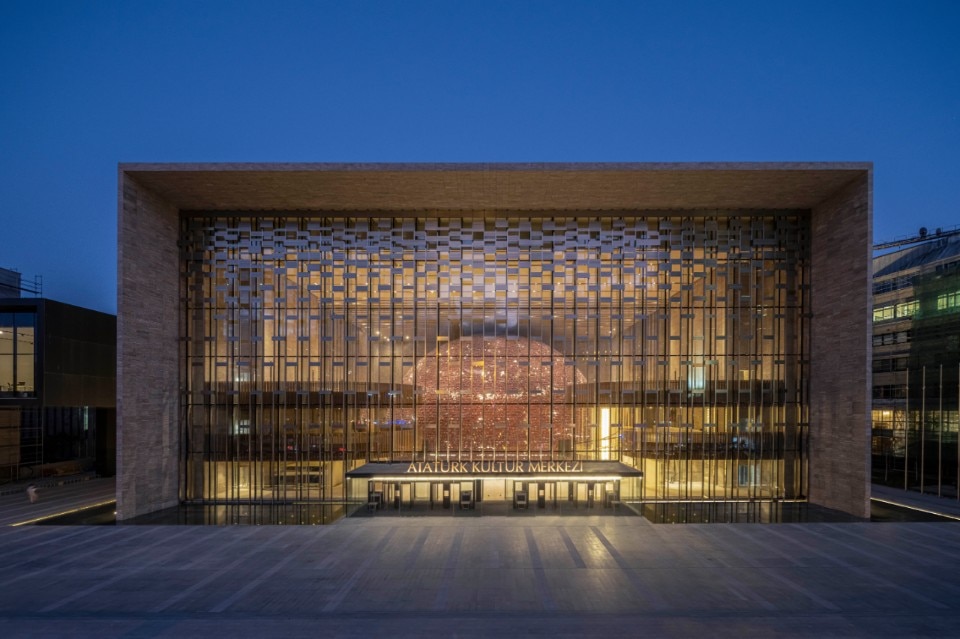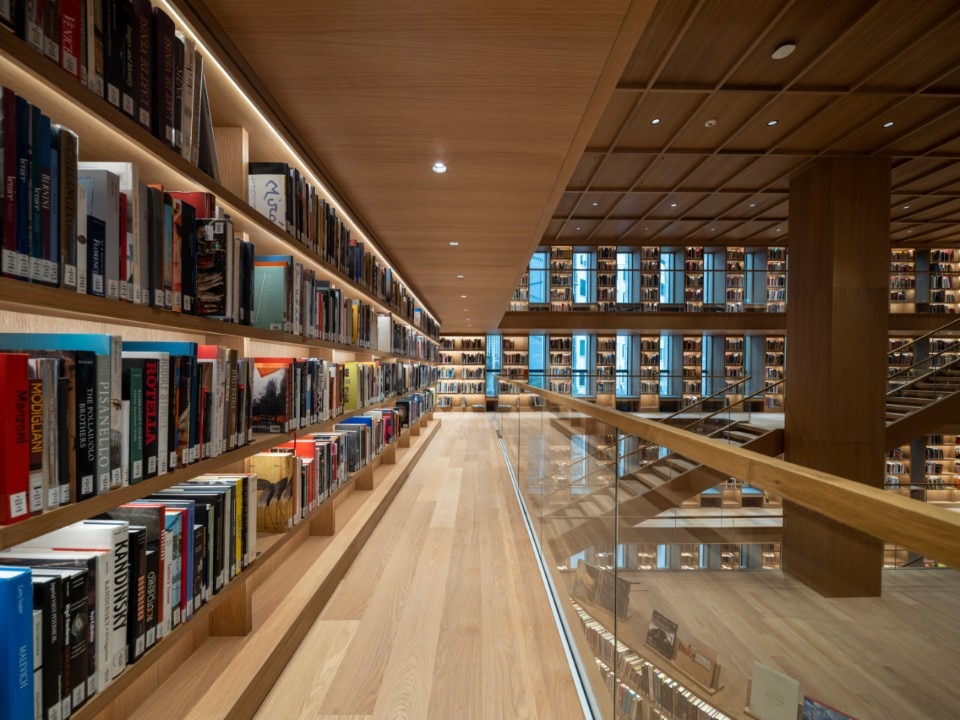The reconstructed Atatürk Cultural Centre in Taksim Square, Istanbul, was inaugurated at the presence of president Erdoğan last October, on the 98th anniversary of the foundation of the Turkish Republic. The newly opened building, which represents the third incarnation of the cultural complex, carries a highly politicized and eventful history.
It first opened its doors as the Palace of Culture in 1969, a venue for “Western” arts such as opera, ballet, and theatre in Taksim square, the centre of modern Istanbul. As earlier projects got scrapped, the final design was drawn up by young architect Hayati Tabanlıoğlu (1927-1994). Amidst shifting governments and budget shortages, it took 23 years to complete the centre, but it burned down less than two years later in a fire – the cause of which is still a matter of political contention.
The palace was then reopened in 1978, this time as Atatürk Cultural Centre (AKM by its Turkish acronym). Since then its bold glass and metal façade, with a minimalist design evoking a theatre curtain, formed the backdrop for the square and for many political rallies and historic events, chiefly left-wing gatherings such as the May 1st demonstrations. The building came to be considered as an architectural emblem of the secular, modern, and Westward-looking Republic.

However, under the Islamist Justice and Development government, the AKM was closed down in 2008, allegedly awaiting much-needed restorations, but raising growing worries of impending demolition. Attempts at renovating it came to nothing, mired in legal disputes between the government and opposition groups. During the 2013 Gezi upheaval – which started in the nearby park – the façade of the idle AKM was turned by demonstrators into a gigantic protest screen. At the time, in a public statement, Erdoğan famously pronounced the vengeful remark: “With God’s will, we will tear the AKM down”. The building’s façade was then employed as a giant banner for advertisement and, following the 2016 coup attempt, for governmental propaganda.
Amid general outcry, and despite the building being listed as a protected cultural asset, demolitions began in 2018. The AKM, which had allegedly reached its life limit, was to be rebuilt and expanded as a cultural centre catering “to the entire populace and not only a portion of the elite” – in the populist narrative often employed by the government. The ideological undertones of this spectacular destruction where hard to miss, especially since a neo-Ottoman mosque was concomitantly rising at the other end of Taksim square.
 View gallery
View gallery

Atatürk Cultural Centre, Taksim square, Istanbul, Turkey
Murat Tabanlıoğlu
Photo Emre Dorter

Atatürk Cultural Centre, Taksim square, Istanbul, Turkey
Murat Tabanlıoğlu
Photo Emre Dorter

Atatürk Cultural Centre, Taksim square, Istanbul, Turkey
Murat Tabanlıoğlu
Photo Emre Dorter

Atatürk Cultural Centre, Taksim square, Istanbul, Turkey
Murat Tabanlıoğlu
Photo Emre Dorter

Atatürk Cultural Centre, Taksim square, Istanbul, Turkey
Murat Tabanlıoğlu
Photo Emre Dorter

Atatürk Cultural Centre, Taksim square, Istanbul, Turkey
Murat Tabanlıoğlu
Photo Emre Dorter

Atatürk Cultural Centre, Taksim square, Istanbul, Turkey
Murat Tabanlıoğlu
Photo Emre Dorter

Atatürk Cultural Centre, Taksim square, Istanbul, Turkey
Murat Tabanlıoğlu
Photo Emre Dorter

Atatürk Cultural Centre, Taksim square, Istanbul, Turkey
Murat Tabanlıoğlu
Photo Emre Dorter

Atatürk Cultural Centre, Taksim square, Istanbul, Turkey
Murat Tabanlıoğlu
Photo Emre Dorter

Atatürk Cultural Centre, Taksim square, Istanbul, Turkey
Murat Tabanlıoğlu
Photo Emre Dorter

Atatürk Cultural Centre, Taksim square, Istanbul, Turkey
Murat Tabanlıoğlu
Photo Emre Dorter

Atatürk Cultural Centre, Taksim square, Istanbul, Turkey
Murat Tabanlıoğlu
Photo Emre Dorter

Atatürk Cultural Centre, Taksim square, Istanbul, Turkey
Murat Tabanlıoğlu
Photo Emre Dorter

Atatürk Cultural Centre, Taksim square, Istanbul, Turkey
Murat Tabanlıoğlu
Photo Emre Dorter

Atatürk Cultural Centre, Taksim square, Istanbul, Turkey
Murat Tabanlıoğlu
Photo Emre Dorter

Atatürk Cultural Centre, Taksim square, Istanbul, Turkey
Murat Tabanlıoğlu
Photo Emre Dorter

Atatürk Cultural Centre, Taksim square, Istanbul, Turkey
Murat Tabanlıoğlu
Photo Emre Dorter

Atatürk Cultural Centre, Taksim square, Istanbul, Turkey
Murat Tabanlıoğlu
Photo Emre Dorter

Atatürk Cultural Centre, Taksim square, Istanbul, Turkey
Murat Tabanlıoğlu
Photo Emre Dorter

Atatürk Cultural Centre, Taksim square, Istanbul, Turkey
Murat Tabanlıoğlu
Photo Emre Dorter

Atatürk Cultural Centre, Taksim square, Istanbul, Turkey
Murat Tabanlıoğlu
Photo Emre Dorter

Atatürk Cultural Centre, Taksim square, Istanbul, Turkey
Murat Tabanlıoğlu
Photo Emre Dorter

Atatürk Cultural Centre, Taksim square, Istanbul, Turkey
Murat Tabanlıoğlu
Photo Emre Dorter

Atatürk Cultural Centre, Taksim square, Istanbul, Turkey
Murat Tabanlıoğlu
Photo Emre Dorter

Atatürk Cultural Centre, Taksim square, Istanbul, Turkey
Murat Tabanlıoğlu
Photo Emre Dorter

Atatürk Cultural Centre, Taksim square, Istanbul, Turkey
Murat Tabanlıoğlu
Photo Emre Dorter

Atatürk Cultural Centre, Taksim square, Istanbul, Turkey
Murat Tabanlıoğlu
Photo Emre Dorter

Atatürk Cultural Centre, Taksim square, Istanbul, Turkey
Murat Tabanlıoğlu
Photo Emre Dorter

Atatürk Cultural Centre, Taksim square, Istanbul, Turkey
Murat Tabanlıoğlu
Photo Emre Dorter

Atatürk Cultural Centre, Taksim square, Istanbul, Turkey
Murat Tabanlıoğlu
Photo Emre Dorter

Atatürk Cultural Centre, Taksim square, Istanbul, Turkey
Murat Tabanlıoğlu
Photo Emre Dorter

Atatürk Cultural Centre, Taksim square, Istanbul, Turkey
Murat Tabanlıoğlu
Photo Emre Dorter

Atatürk Cultural Centre, Taksim square, Istanbul, Turkey
Murat Tabanlıoğlu
Photo Emre Dorter

Atatürk Cultural Centre, Taksim square, Istanbul, Turkey
Murat Tabanlıoğlu
Photo Emre Dorter

Atatürk Cultural Centre, Taksim square, Istanbul, Turkey
Murat Tabanlıoğlu
Photo Emre Dorter
The reconstruction was entrusted to Murat Tabanlıoğlu, son of the original architect, running the namesake practice that has by now evolved into an international studio with offices in Istanbul, New York and Dubai. The new design largely maintains the outer appearance and volumes of the previous structure, complementing it with a sweeping expansion. The aim was to turn the former opera house into a multipurpose cultural complex, open at all times. Over a 95,000 sqm surface, the new AKM contains a variety of new functions.
The iconic façade overlooking Taksim square was rebuilt, albeit in a slightly altered version: it recedes a few meters from its frame, creating a sort of canopy. While preserving the AKM’s outer image the front prospect reveals – in particular at night – the most recognizable element of the new design: the 2000-seat concert hall, which is contained in a large hemispheric element. It is clad in bright red tiles, which were crafted as enlarged versions of the ceramic tiles present in the old AKM. Other elements of the original design have been reproduced or reinterpreted, such as the striking spiral staircase in the main foyer.

The expansion spreads on the site of a former parking lot, behind the mid-rise buildings lining Gezi Park. Four blocks of decreasing heights are arranged around a descending sequence of staircases, which follows the slope of the hill and leads to an outdoor space opening towards Taşkışla and the Atatürk Library. Along this axis, labeled “Culture Way”, one can find a theatre, a cinema, a library, multipurpose and exhibition halls, a hall for children activities, bars, and restaurants. A rectangular volume hosting an art gallery is suspended between the mass of the original AKM and the expansion, creating an ample entry space at ground level. Its glass façade, protruding onto the square, is enlivened by digital animations.
The overall structure has a monumental, if somewhat austere, feel. Some interior spaces, such as the wood-clad library, are well-finished and welcoming, whereas the connecting semi-open spaces result hastily completed and wintry. Besides the grand frontage towards Taksim, the connection between the complex and its surroundings seems to have been overlooked, but works to improve it are apparently ongoing.

Only once the AKM gets fully operational and its broad spaces get populated by people and activities, it will be possible to assess its success. To this end, beyond the architectural qualities of the complex, its cultural programming will be crucial. The upgrading of the pre-existing modernist artifact would have definitely been desirable, and its erasure is clearly ascribable to political calculations as much as technical assessments. Yet the new AKM is a worthwhile attempt at combining the preservation of the historical memory with the needs of contemporary cultural production, all within a highly polarized political context. Istanbul eventually got a public cultural space of great potential, and as different commentators in Turkey have pointed out, it is now time for the citizenry to enjoy it, but without forgetting its past.



